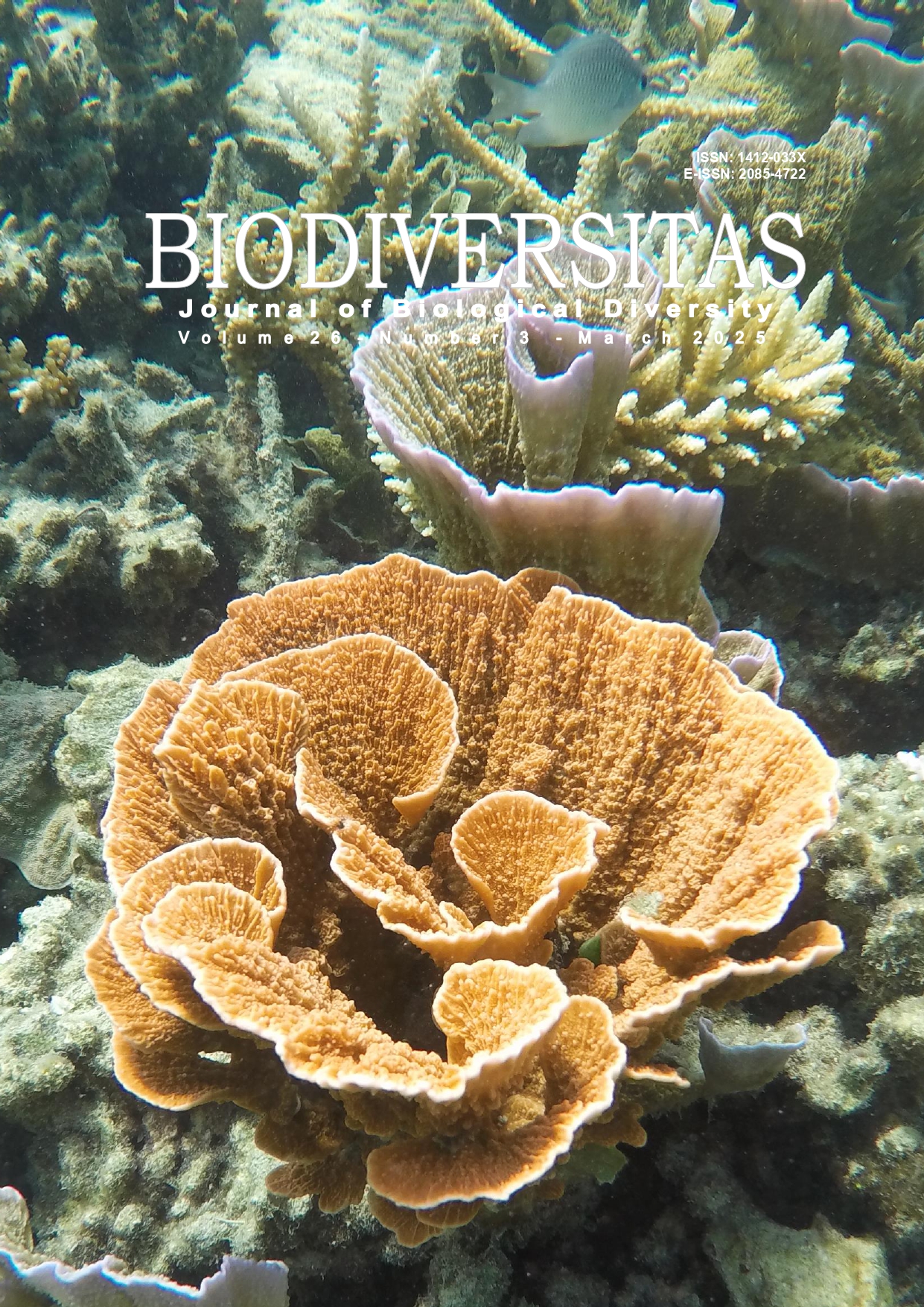Diversity, abundance, and ecological roles of insect pollinators in red guava flowers (Psidium guajava) in East Java, Indonesia
##plugins.themes.bootstrap3.article.main##
Abstract
Abstract. Purwantiningsih B, Leksono AS, Yanuwiyadi B, Gama ZP, Abdullah SA. 2025. Diversity, abundance, and ecological roles of insect pollinators in red guava flowers (Psidium guajava) in East Java, Indonesia. Biodiversitas 26: 1211-1219. Red guava (Psidium guajava) is a high-value crop with relatively easy cultivation requirements. However, the decline in pollinating insects is a global issue that has led to reduced guava productivity and harvest yields. This study aimed to analyze the abundance, richness, diversity, evenness, and dominance of insects visiting red guava flowers, as well as to visually examine their visitation patterns across five locations in East Java, Indonesia: Pademonegoro, Tlekung, Oro-Oro Ombo, Junrejo, and Mulyoagung, and assess the ecological roles. A total of 3432 individual insects from 17 families and five orders were identified, with pollinators dominating in all locations. Junrejo exhibited the highest abundance (29.11%) but low diversity (0.78), whereas Pademonegoro had the highest diversity (1.80) with moderate abundance. Statistical analysis revealed no significant differences in insect composition between locations (p>0.05), although PCA analysis indicated variations in insect characteristics at certain sites. Insect activity was influenced by flowering periods, temperature, and light intensity, with peak activity varying across locations. These findings underscore the critical role of pollinators, particularly the Apidae family, in red guava pollination, highlighting their significant contribution. The study also highlights the diverse adaptations of insect communities to their local environments, providing insights into sustainable agroecosystem management through pollinator conservation.
##plugins.themes.bootstrap3.article.details##
Most read articles by the same author(s)
- AMIN SETYO LEKSONO, BAGYO YANUWIADI, AINUL KHOTIMAH, ANISA ZAIRINA, Grasshopper diversity in several agricultural areas and savannas in Dompu, Sumbawa Island, Indonesia , Biodiversitas Journal of Biological Diversity: Vol. 23 No. 1 (2022)
- AMIN SETYO LEKSONO, BAGYO YANUWIADI, AMINUDIN AFANDHI, MOHAMMAD FARHAN, ANISA ZAIRINA, The abundance and diversity of grasshopper communities in relation to elevation and land use in Malang, Indonesia , Biodiversitas Journal of Biological Diversity: Vol. 21 No. 12 (2020)
- YUNITA FERA RAHMAWATI, AMIN SETYO LEKSONO, AKHMAD RIZALI, ZULFAIDAH PENATA GAMA, Population dynamics of Bactrocera spp., and parasitization efficacy of Opius sp. (Hymenoptera: Braconidae) in citrus varieties , Biodiversitas Journal of Biological Diversity: Vol. 25 No. 11 (2024)
- AMINUDIN AFANDHI, ELYKA PUTRI PERTIWI, DICKY PREJEKI PURBA, TITA WIDJAYANTI, AMIN SETYO LEKSONO, The diversity of entomopathogenic fungi collected from leaves and rhizospheres of rice implementing integrated pest management , Biodiversitas Journal of Biological Diversity: Vol. 21 No. 6 (2020)
- FOUAD FAUZI, SUEMARNO, AMINUDIN AFANDHI, AMIN SETYO LEKSONO, Nesting behavior of Bornean immature Orangutan (Pongo pygmaeus wurmbii) in Nyaru Menteng Arboretum School, Palangka Raya, Central Kalimantan, Indonesia , Biodiversitas Journal of Biological Diversity: Vol. 21 No. 5 (2020)
- AMIN SETYO LEKSONO, BAGYO YANUWIADI, NAJMATUL MILLAH, SAIFUL ARIF ABDULLAH, Butterfly diversity along an altitudinal gradient and land uses in East Java, Indonesia , Biodiversitas Journal of Biological Diversity: Vol. 26 No. 2 (2025)
- MUHAMAD AZMI DWI SUSANTO, ZULFAIDAH PENATA GAMA, AMIN SETYO LEKSONO, Habitat characteristics and threats of little-known endemic dragonfly, Neurothemis feralis (Burmeister, 1839) (Odonata: Libellulidae) in East Java, Indonesia , Biodiversitas Journal of Biological Diversity: Vol. 25 No. 7 (2024)


 https://orcid.org/0009-0002-4711-4032
https://orcid.org/0009-0002-4711-4032